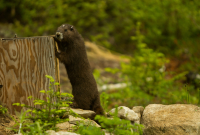Moose in Quebec's Parc La Vérendyre were once plentiful enough Waba Moko could fill her freezer with meat each winter and use the hides to run a small mukluk-making business. No longer. The park's moose populations have declined in recent years, pushing Moko, an Anishinabe (Algonquin) land defender, to rely on store-bought meat and direct her energies to fighting against the animals' decline.
In 2019, Moko played a key role in co-ordinating blockades against outside sport hunters erected by Anishinabe (Algonquin) land defenders on roads leading into the vast expanse of boreal forest. An aerial survey conducted by the provincial government that year showed moose populations declined 35 per cent compared to the previous assessment in 2008. The findings corroborated Algonquin elders' observations of how logging and sport hunting were impacting moose, prompting the blockades.
Indigenous people have a constitutional right to hunt that the provinces must protect, and many rely on moose for their meat, hide and cultural importance. In contrast, though many non-Indigenous Canadians depend on moose for food, recreation and livelihoods, provincial governments do not need to allocate them hunting permits — particularly if populations are struggling.
The Anishinabe blockades led to a two-year moratorium on sport hunting in the park. It is due to end this year, but Moko has joined fellow activists and researchers saying future restrictions are essential to protect the moose.
Moose populations are declining in many provinces, with the exception of Newfoundland and Nova Scotia’s Cape Breton. Wildlife researchers and First Nations say logging, sport hunting and climate change are to blame. The stakes are high. In rural Canada, where transportation costs can boost already soaring food prices higher, moose are both an essential source of meat and culturally important.
Canada hasn't assessed the health of the country's moose populations. But there are an increasing number of reported declines originating everywhere from the Cree territories in northern Quebec to British Columbia's Interior.
"Moose biology isn't rocket science — it's more complex than that," said University of Northern British Columbia moose biologist Roy Rea, noting the quip was first used by University of British Columbia professor Fred Bunnell to describe forestry. "It's a perfect storm of climate (change), over-harvesting of trees, too many roads, parasites and disease, hunters with high-powered rifles and sniper scopes. It's cumulative impacts."
Climate change is generally driving warmer, wetter and snowier winters. These conditions can make it harder for moose to find food or travel through crusted snow. Hot, dry summers are also stressful for moose.
Industrial activities like fossil fuel development or mining can impact populations by building roads that fragment vital habitat. Roads make it easier for people to hunt in areas that were previously mostly inaccessible and may expose moose to natural predators like wolves that use roads for travel.
Over-hunting — whether legal sport hunting or poaching — adds another threat to moose populations, no matter how small.
These concerns were echoed in a landmark case last year between the B.C. government and the Blueberry River First Nation. The ruling found that declining moose and caribou populations in the nation's territory in northern B.C. were caused by the provincial government's failure to protect the animals' habitat from harmful industrial development.
"But industrial clear cut logging," Rea said," stands out as particularly harmful of all the threats moose face."
Some industrial logging practices can be brutal on forests, he explained. The vast clearcuts that fracture forests across Canada leave moose little protection from harsh weather and predators.
Tree plantations that replace the forests logging companies have harvested are of little use to moose. Moose can't eat most commonly used plantation species, and for years after clear cutting they are too small to offer much protection. The herbicides some logging companies use to kill the fast-growing leafy plants that compete with their newly planted trees also kill some of moose's favorite foods.
With few indications that companies will change their forestry practices, hunting has become a flashpoint for controversy.
This summer, the Tŝilhqot’in Nation in B.C. condemned the provincial government's decision to increase moose hunting quotas in the Chilcotin Region. Tensions have also flared further north after the B.C. government implemented significant restrictions on non-Indigenous hunters in the Peace Region "to support reconciliation and improve wildlife stewardship." The measures were condemned as an "unreasonable departure from science-based management" by the province's sport hunting lobby.
Further east, in Quebec, those tensions have at times risked getting ugly, said Melissa Mollen-Dupuis, the David Suzuki Foundation's Montreal-based forest campaign manager. Many non-Indigenous Quebecers resent the efforts by Indigenous people like the Anishnabe or her people — the Innu — to curtail moose hunting for conservation. She would like to see the provincial government take a stronger stance on the issue by changing hunting and forestry regulations.
Back in La Vérendyre, Moko is hopeful that new hunting rules could help alleviate tensions with non-Indigenous hunters, ensure her people have enough moose and help the populations bounce back.
Reducing the sport hunt from its pre-moratorium levels would help. So would reducing poaching. Teaching both Anishinabe and non-Indigenous hunters how to hunt more responsibly and creating a way for sport hunters to donate unwanted parts of their moose to First Nations could offer another way to protect the herds and meet each group's needs.
"It's (about) being really mindful of the population," she said. "It's really a lot about building responsibility and respect."






Comments
I wish to live in a world where humans protect moose and other species for their own sake -- not so people can kill them.